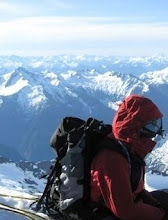When: Sunday, May 17th, 2009
With: BoeAlps BCC Team 7
Goal: Practice Crevasse Rescue

5:30 rang in the ears of Team 7 holding up in Whittaker’s Bunkhouse. Side Note: warmer nights may not be the best time to book an attic room!
Most of us grabbed breakfast as we slipped on different base layers. It was already pretty warm outside forecasting a brutally hot day on the reflective glacier.
We arrived at Paradise (the main Rainier are with the Ranger station, and start to many of the trails going around the park and the most popular routes to the summit of Rainier.
Shortly after starting the trail towards Muir (Rainier basecamp) we were instructed to put on our crampons. They weren’t necessary for this specific part of the trail but it would act as a practice to prepare for our graduation climb coming up shortly—where crampons would most likely be needed.
There were over 80 students and instructors on the Nisqually Glacier; to others it probably looked like a rouge army taking over. Our destination was a large open crevasse. We turned off the beaten Muir path and soon enough we were able to take off the crampons and trade it in for being tied onto a rope with another student and instructor.

Unfortunately, before we were able to rid ourselves of the crampons Todd gashed his gaiters, a $50 bumout. We tied into the rope in case a member fell through a snowbridge and into a crevasse or in case one of us found a new crevasse in general. The hope is that only one person would fall and the other two people tied to the same rope would be able to arrest, and a) stop the fall b) prevent more people from falling into the crevasse and c) enable the rest of the team to assist in getting the fallen climber out.
Fortunately, none of us fell into any unknown crevasse, on accident. The goal of the day was not only to practice crampon and rope travel but also to perform a crevasse rescue. Each of us played a key role in simulating a rescue. For safety we added a belayer who would have an extra rope tied to the person in the crevasse in case the rescue team was unable to perform the rescue properly.

A student would be lowered into the crevasse with 2 ropes on them. One being the safety belay (not present in “real life” rescue) and the other rope would be the glacier travel rope. The student could try to prussic up the rope (climbing up the rope with the aid of smaller ropes which would be attached to the harness). This would be the ‘best case’ scenario—the team was able to arrest and the fallen climber would be able to get themselves out of the crevasse without additional help.

Since the ‘best case’ scenario is not guaranteed we did not allow the climber to get to the top.

Initially, the two other climbers on the rope would arrest with their ice axes. After this was done, the climber the furthest away would come down to start setting up the pulley system (once they confirmed that the middle climber was able to keep the arrest with the weight of the fallen climber).

The top climber would then set up two anchors to take the weight of the fallen climber and to ensure the arrested climber did not slip.

Then, as a team, the two climbers would continue the rescue, setting up the pulley system. Even with a z-pulley system (a mechanical rescue using 2 pulleys) the fallen climber was still hard to pick up.

Before we knew it we had our rescue down to 20 minutes (up from about an hour). Sadly, this is not a real statistic for our subsequent rescues all had the anchors placed. One would probably be lucky to set up the z-pulley system in under an hour in real life. The group can just hope that if a member is unfortunate enough to fall into a crevasse, the fallen climber is not hurt so badly that they are unable to prussic back up.

Overall, the crevasse rescue outing made taking the BCC class completely worth it. The real-life experience of being lowered into a crevasse and performing rescue really makes you appreciate the dangers that are out there. I hope I never have to perform such, but if I must, I feel I’ll be much more prepared.
In terms of the hike itself, I actually felt the worst on this outing and was slower than ever before (ALMOST becoming the slowest in the group). I am positive it was because of the beating sun (and maybe a tiny bit from the 32 mile bike ride the day before). My body doesn’t regulate heat very well and I was sweating moments after leaving the parking lot, when I was only in my base layer. At the end of the day, when the sun wasn’t as intense my energy picked up, and I even led the team home up the steepest hill.

No comments:
Post a Comment